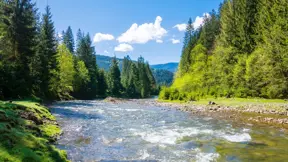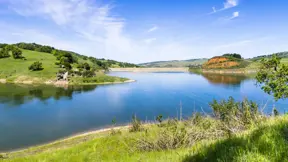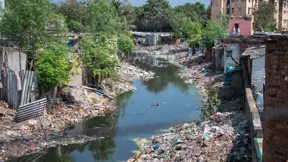
The rising waters of Lake Turkana: a story of friend turned foe
Why we need to understand changes in water and climate patterns to take action
In Africa, locals have formed a close connection with their lakes and rivers over millennia. People live in villages along great bodies of water, such as Lake Turkana, which straddles Kenya and Ethiopia. Local fishers rely on the catch they get from the lake’s jade-coloured waters, and children play in the shallows, wary of crocodiles and hippos. The adage of freshwater being a precious source of life takes on a whole new meaning in the case of Lake Turkana, the world’s largest permanent desert lake.
Challenge
Lake Turkana and its river basins, including that of the Omo River, are vital for the people, economies and wildlife of both Kenya and Ethiopia. The Omo River delta and Lake Turkana are rich in biodiversity, support endangered species such as flamingo, and its fish are important to the local economy.
The region around Lake Turkana is vulnerable to drought. In recent times, concerns have grown about low lake levels due to climate change and the damming of one of the lake’s main inflows, the Omo River, which originates in Ethiopia and empties into the northern part of the lake.
It was, therefore, a surprise to many when devastating floods1 hit lakeside settlements in 2020, damaging the livelihoods of thousands of people, destroying homes, and affecting wildlife.
However, a recent study by the UNEP-DHI Centre, on behalf of the United Nations Environment Programme (UNEP), indicates that such floods may become a more regular occurrence in years to come. It found that climate change could increase the likelihood of both drought and flooding around Lake Turkana due to erratic precipitation, and that livelihoods could be affected if no adaptation measures are implemented. Deforestation and cultivation on steep slopes have already led to landslides, flooding and land degradation.
The study proposed a number of measures to address the situation, but not all are easy to implement. One example is to improve the dialogue between Ethiopia and Kenya so both nations see the mutual benefits of managing the Omo River collaboratively.
One of the reasons Lake Turkana is so vulnerable to flooding is that it has no natural outlet, which makes it prone to changes during increased and decreased inflow. The largest inflow comes from the Omo River and its tributaries in Ethiopia. In recent years, the natural river inflow has been thought to be affected by large-scale dam development in Ethiopia. The dams generate electricity and facilitate agricultural production which Ethiopia regards as essential for its development.
1 Basin modelling and prioritization of rehabilitation interventions (unepdhi.org) p. 80
Partner:
Location:
Ethiopia
Kenya
Related SDG(s):
SDG 6: Ensure availability and sustainable management of water and sanitation for all
SDG 11: Make cities and human settlements inclusive, safe, resilient and sustainable
SDG 13: Take urgent action to combat climate change and its impacts
Solution
Studies, such as the UNEP-DHI Centre study, can be a critical first step in identifying and quantifying the root causes of flooding. The study sought to:
- Establish a joint scientific understanding of the lake and its river basins
- Set up a monitoring system for Lake Turkana and its river basins
- Evaluate scenarios to tackle the specific issues and hotspots identified, combining water resources developments, rehabilitation and adaptation measures, and climate change projections
- Implement pilot demonstrations for ecosystem rehabilitation
Based on detailed scenario modelling, the work undertaken generated elements to support dialogue and water diplomacy between the two nations. This included the identification of possible initiatives that could help mitigate the effects of climate change, such as the building of barriers around the lake to help prevent flooding.
One scenario demonstrated that it is possible to maintain and even improve hydropower production in Ethiopia while achieving a certain balance in Lake Turkana water levels. This would require that Ethiopia develop alternative power sources for the dry season. If this were possible, it would provide a way to meet some of the ecological requirements of Lake Turkana and the surrounding area while respecting Ethiopia’s need for hydropower.
Another example of scenario modelling focused on reforestation, soil and water conservation. The aim was to assess how reforestation, agroforestry, and soil and water conservation measures may reduce flooding, soil erosion and landslides. The conclusion was that reforestation, agroforestry and soil and water have an impact on the water balance, the path the water takes, as well as soil and nutrient balances.’2 Downstream, ‘the risk of flash floods and flooding in general are considerably reduced’ and there would be ‘a clear improvement of the water quality in the rivers downstream, including less turbidity and less E. coli.’3
2Basin modelling and prioritization of rehabilitation interventions (unepdhi.org) p. 49.
3Basin modelling and prioritization of rehabilitation interventions (unepdhi.org) p. 53.
Results
Countries such as Ethiopia and Kenya that share water bodies can benefit from cooperation that can have a positive impact on the basin, the ecosystem, the economy and people. Ethiopia and Kenya now have access to planning and water resource management scenarios that translate into win-win situations and represent a better way forward for the Omo-Turkana Basin.
- Increased irrigation and other abstractions within the basin may help to counterbalance increasing water levels in Lake Turkana due to climate change
- It may be possible to partly reproduce seasonal inflows to Lake Turkana that can maintain fish and hydropower production in the basin
- Soil and water conservation and reforestation measures can significantly reduce the risk of landslides and mudflows
‘Through this study, we are able to demonstrate how to use scientific evidence to validate or challenge prevailing theories and to show that win-win scenarios can be achieved via close collaboration, both at the technical expert and decision-maker levels. UNEP is now in a better position to support cross-border dialogue between Ethiopia and Kenya. The local authorities involved in the project strengthened their ability to study environmental issues in their catchment and the root causes of those issues. They also learnt how to test the benefits of different solutions.’
Joakim Harlin, Chief of Freshwater Ecosystems
United Nations Environment Programme (UNEP)
About our partner
Since its inception in 1972, UNEP has been the global authority that sets the environmental agenda, promotes the coherent implementation of the environmental dimension of sustainable development within the United Nations system and serves as an authoritative advocate for the global environment. Learn more about the work they do in water: www.unep.org/explore-topics/water
You may also like
How can we help?
With our global network of offices, we make sure you get the right answers to your local needs. Tell us about your water challenges and we will get back to you.


